Employee Motivation: Monetary and Non-Monetary Rewards Analysis
VerifiedAdded on 2023/01/19
|8
|2265
|41
Essay
AI Summary
This research essay delves into the concept of employee motivation within organizational behavior, examining the impact of both monetary and non-monetary rewards on employee performance and employment relationships. It analyzes the perspectives of various researchers, highlighting the pros and cons of financial incentives, as well as the significance of intrinsic rewards like appreciation and job satisfaction. The essay discusses expectancy theory, Maslow's hierarchy of needs, and the potential drawbacks of financial rewards, such as demotivation and conflicts. It also explores goal theory, McGregor's Theory X and Y, and Herzberg's Two-Factor theory, offering recommendations for training and performance-based rewards. The essay concludes that monetary rewards are a prime motivator but should be implemented carefully, with training and individual performance considerations to foster positive employment relationships and enhance organizational productivity.
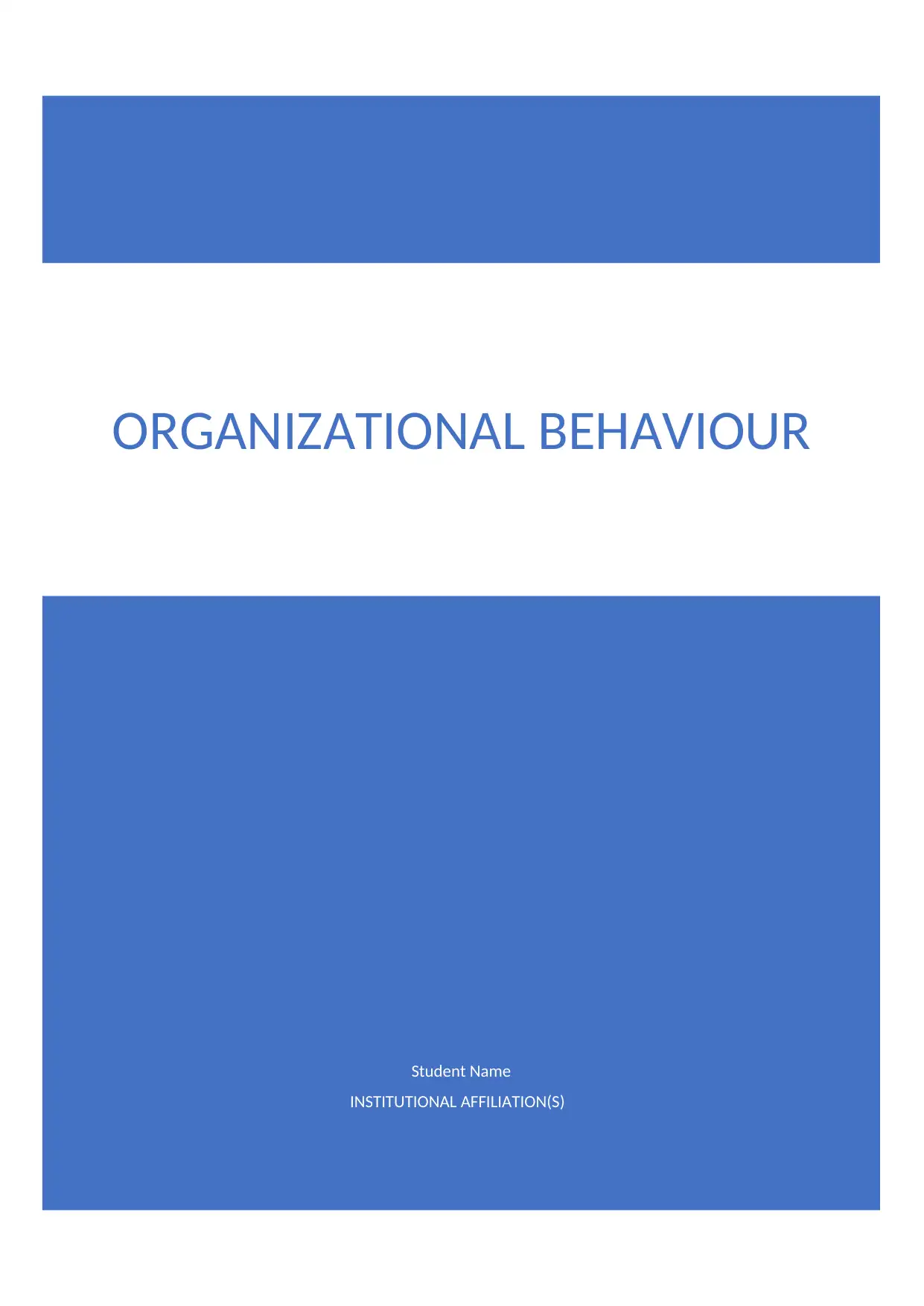
Student Name
INSTITUTIONAL AFFILIATION(S)
ORGANIZATIONAL BEHAVIOUR
INSTITUTIONAL AFFILIATION(S)
ORGANIZATIONAL BEHAVIOUR
Paraphrase This Document
Need a fresh take? Get an instant paraphrase of this document with our AI Paraphraser
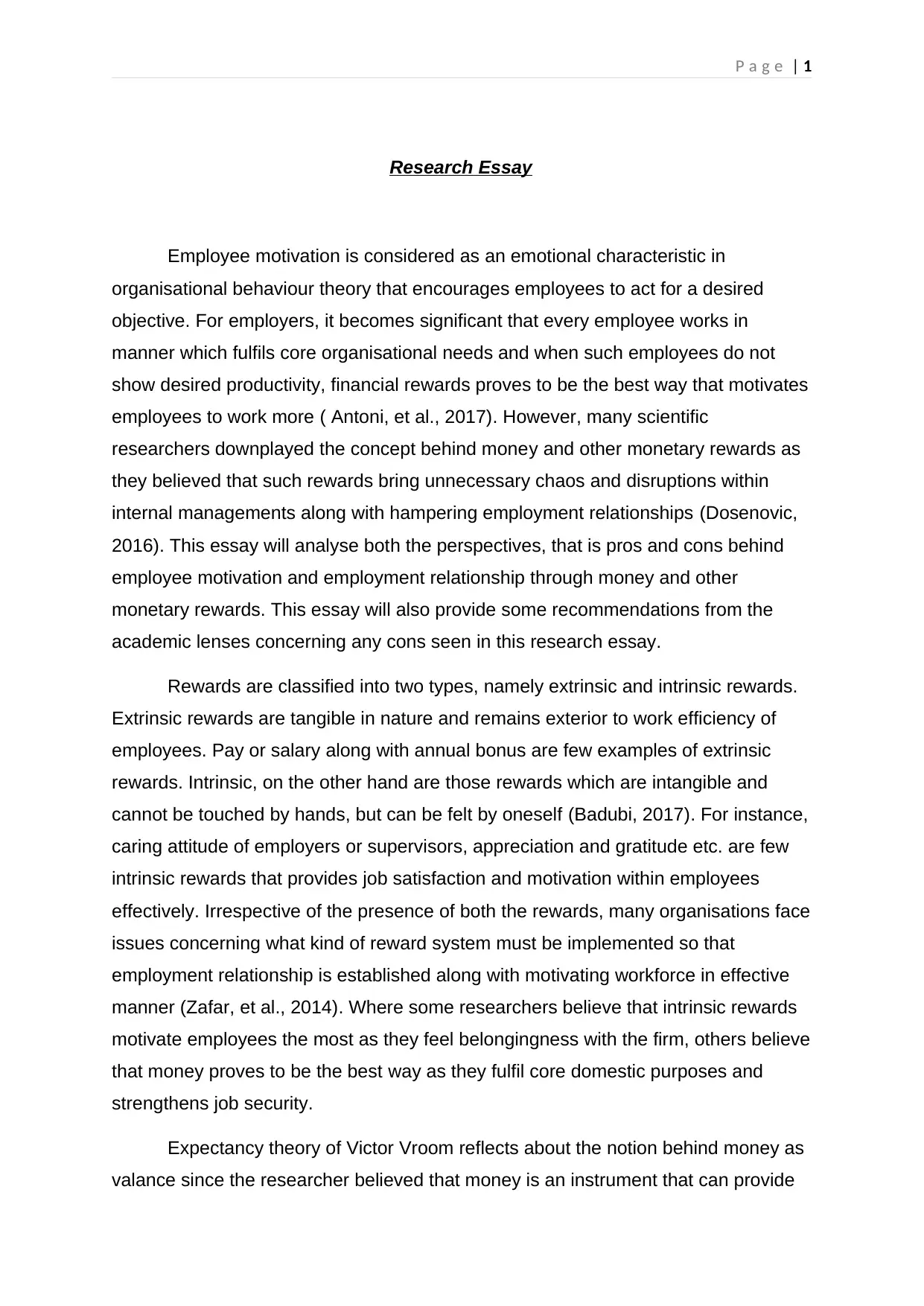
P a g e | 1
Research Essay
Employee motivation is considered as an emotional characteristic in
organisational behaviour theory that encourages employees to act for a desired
objective. For employers, it becomes significant that every employee works in
manner which fulfils core organisational needs and when such employees do not
show desired productivity, financial rewards proves to be the best way that motivates
employees to work more ( Antoni, et al., 2017). However, many scientific
researchers downplayed the concept behind money and other monetary rewards as
they believed that such rewards bring unnecessary chaos and disruptions within
internal managements along with hampering employment relationships (Dosenovic,
2016). This essay will analyse both the perspectives, that is pros and cons behind
employee motivation and employment relationship through money and other
monetary rewards. This essay will also provide some recommendations from the
academic lenses concerning any cons seen in this research essay.
Rewards are classified into two types, namely extrinsic and intrinsic rewards.
Extrinsic rewards are tangible in nature and remains exterior to work efficiency of
employees. Pay or salary along with annual bonus are few examples of extrinsic
rewards. Intrinsic, on the other hand are those rewards which are intangible and
cannot be touched by hands, but can be felt by oneself (Badubi, 2017). For instance,
caring attitude of employers or supervisors, appreciation and gratitude etc. are few
intrinsic rewards that provides job satisfaction and motivation within employees
effectively. Irrespective of the presence of both the rewards, many organisations face
issues concerning what kind of reward system must be implemented so that
employment relationship is established along with motivating workforce in effective
manner (Zafar, et al., 2014). Where some researchers believe that intrinsic rewards
motivate employees the most as they feel belongingness with the firm, others believe
that money proves to be the best way as they fulfil core domestic purposes and
strengthens job security.
Expectancy theory of Victor Vroom reflects about the notion behind money as
valance since the researcher believed that money is an instrument that can provide
Research Essay
Employee motivation is considered as an emotional characteristic in
organisational behaviour theory that encourages employees to act for a desired
objective. For employers, it becomes significant that every employee works in
manner which fulfils core organisational needs and when such employees do not
show desired productivity, financial rewards proves to be the best way that motivates
employees to work more ( Antoni, et al., 2017). However, many scientific
researchers downplayed the concept behind money and other monetary rewards as
they believed that such rewards bring unnecessary chaos and disruptions within
internal managements along with hampering employment relationships (Dosenovic,
2016). This essay will analyse both the perspectives, that is pros and cons behind
employee motivation and employment relationship through money and other
monetary rewards. This essay will also provide some recommendations from the
academic lenses concerning any cons seen in this research essay.
Rewards are classified into two types, namely extrinsic and intrinsic rewards.
Extrinsic rewards are tangible in nature and remains exterior to work efficiency of
employees. Pay or salary along with annual bonus are few examples of extrinsic
rewards. Intrinsic, on the other hand are those rewards which are intangible and
cannot be touched by hands, but can be felt by oneself (Badubi, 2017). For instance,
caring attitude of employers or supervisors, appreciation and gratitude etc. are few
intrinsic rewards that provides job satisfaction and motivation within employees
effectively. Irrespective of the presence of both the rewards, many organisations face
issues concerning what kind of reward system must be implemented so that
employment relationship is established along with motivating workforce in effective
manner (Zafar, et al., 2014). Where some researchers believe that intrinsic rewards
motivate employees the most as they feel belongingness with the firm, others believe
that money proves to be the best way as they fulfil core domestic purposes and
strengthens job security.
Expectancy theory of Victor Vroom reflects about the notion behind money as
valance since the researcher believed that money is an instrument that can provide
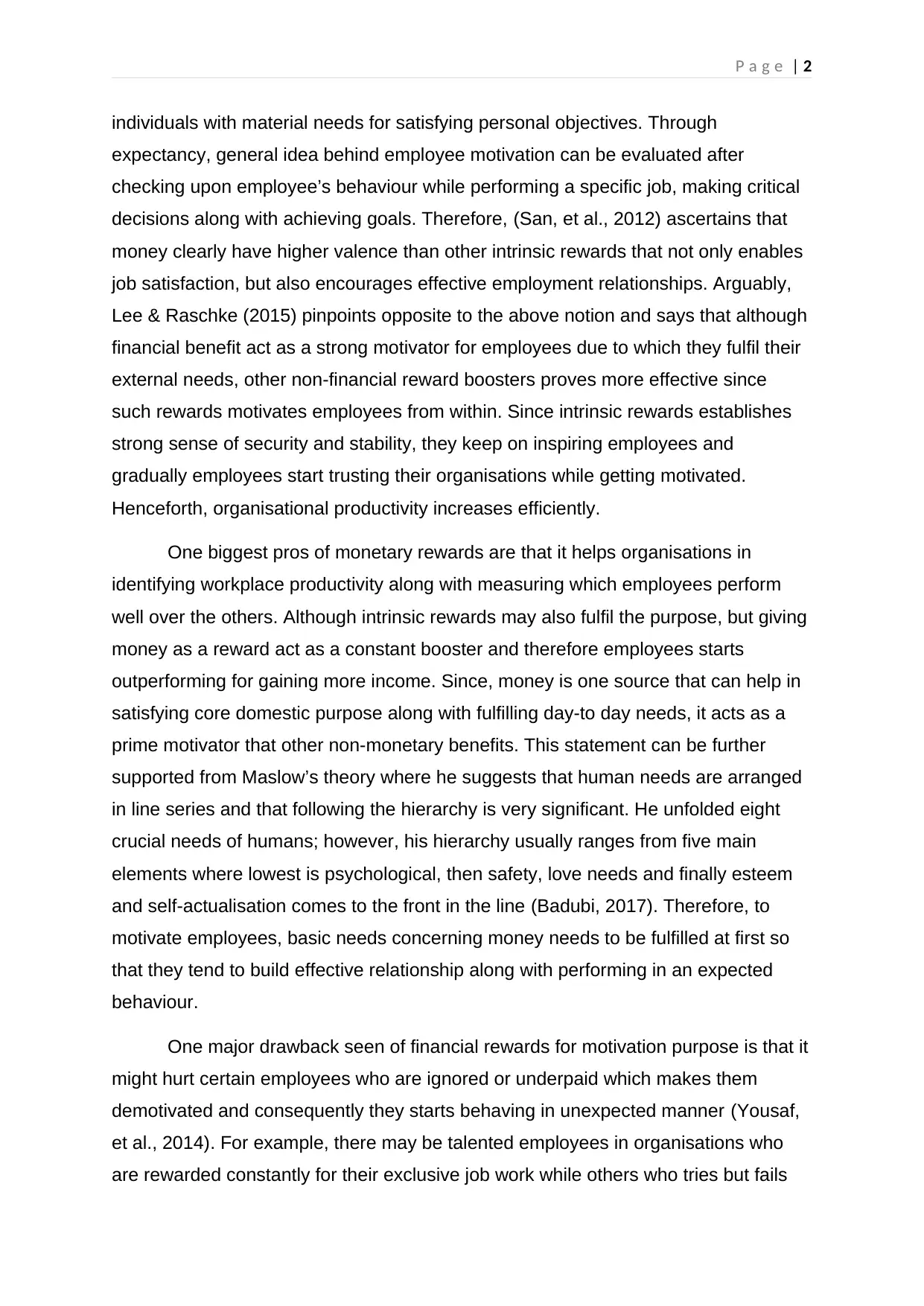
P a g e | 2
individuals with material needs for satisfying personal objectives. Through
expectancy, general idea behind employee motivation can be evaluated after
checking upon employee’s behaviour while performing a specific job, making critical
decisions along with achieving goals. Therefore, (San, et al., 2012) ascertains that
money clearly have higher valence than other intrinsic rewards that not only enables
job satisfaction, but also encourages effective employment relationships. Arguably,
Lee & Raschke (2015) pinpoints opposite to the above notion and says that although
financial benefit act as a strong motivator for employees due to which they fulfil their
external needs, other non-financial reward boosters proves more effective since
such rewards motivates employees from within. Since intrinsic rewards establishes
strong sense of security and stability, they keep on inspiring employees and
gradually employees start trusting their organisations while getting motivated.
Henceforth, organisational productivity increases efficiently.
One biggest pros of monetary rewards are that it helps organisations in
identifying workplace productivity along with measuring which employees perform
well over the others. Although intrinsic rewards may also fulfil the purpose, but giving
money as a reward act as a constant booster and therefore employees starts
outperforming for gaining more income. Since, money is one source that can help in
satisfying core domestic purpose along with fulfilling day-to day needs, it acts as a
prime motivator that other non-monetary benefits. This statement can be further
supported from Maslow’s theory where he suggests that human needs are arranged
in line series and that following the hierarchy is very significant. He unfolded eight
crucial needs of humans; however, his hierarchy usually ranges from five main
elements where lowest is psychological, then safety, love needs and finally esteem
and self-actualisation comes to the front in the line (Badubi, 2017). Therefore, to
motivate employees, basic needs concerning money needs to be fulfilled at first so
that they tend to build effective relationship along with performing in an expected
behaviour.
One major drawback seen of financial rewards for motivation purpose is that it
might hurt certain employees who are ignored or underpaid which makes them
demotivated and consequently they starts behaving in unexpected manner (Yousaf,
et al., 2014). For example, there may be talented employees in organisations who
are rewarded constantly for their exclusive job work while others who tries but fails
individuals with material needs for satisfying personal objectives. Through
expectancy, general idea behind employee motivation can be evaluated after
checking upon employee’s behaviour while performing a specific job, making critical
decisions along with achieving goals. Therefore, (San, et al., 2012) ascertains that
money clearly have higher valence than other intrinsic rewards that not only enables
job satisfaction, but also encourages effective employment relationships. Arguably,
Lee & Raschke (2015) pinpoints opposite to the above notion and says that although
financial benefit act as a strong motivator for employees due to which they fulfil their
external needs, other non-financial reward boosters proves more effective since
such rewards motivates employees from within. Since intrinsic rewards establishes
strong sense of security and stability, they keep on inspiring employees and
gradually employees start trusting their organisations while getting motivated.
Henceforth, organisational productivity increases efficiently.
One biggest pros of monetary rewards are that it helps organisations in
identifying workplace productivity along with measuring which employees perform
well over the others. Although intrinsic rewards may also fulfil the purpose, but giving
money as a reward act as a constant booster and therefore employees starts
outperforming for gaining more income. Since, money is one source that can help in
satisfying core domestic purpose along with fulfilling day-to day needs, it acts as a
prime motivator that other non-monetary benefits. This statement can be further
supported from Maslow’s theory where he suggests that human needs are arranged
in line series and that following the hierarchy is very significant. He unfolded eight
crucial needs of humans; however, his hierarchy usually ranges from five main
elements where lowest is psychological, then safety, love needs and finally esteem
and self-actualisation comes to the front in the line (Badubi, 2017). Therefore, to
motivate employees, basic needs concerning money needs to be fulfilled at first so
that they tend to build effective relationship along with performing in an expected
behaviour.
One major drawback seen of financial rewards for motivation purpose is that it
might hurt certain employees who are ignored or underpaid which makes them
demotivated and consequently they starts behaving in unexpected manner (Yousaf,
et al., 2014). For example, there may be talented employees in organisations who
are rewarded constantly for their exclusive job work while others who tries but fails
⊘ This is a preview!⊘
Do you want full access?
Subscribe today to unlock all pages.

Trusted by 1+ million students worldwide
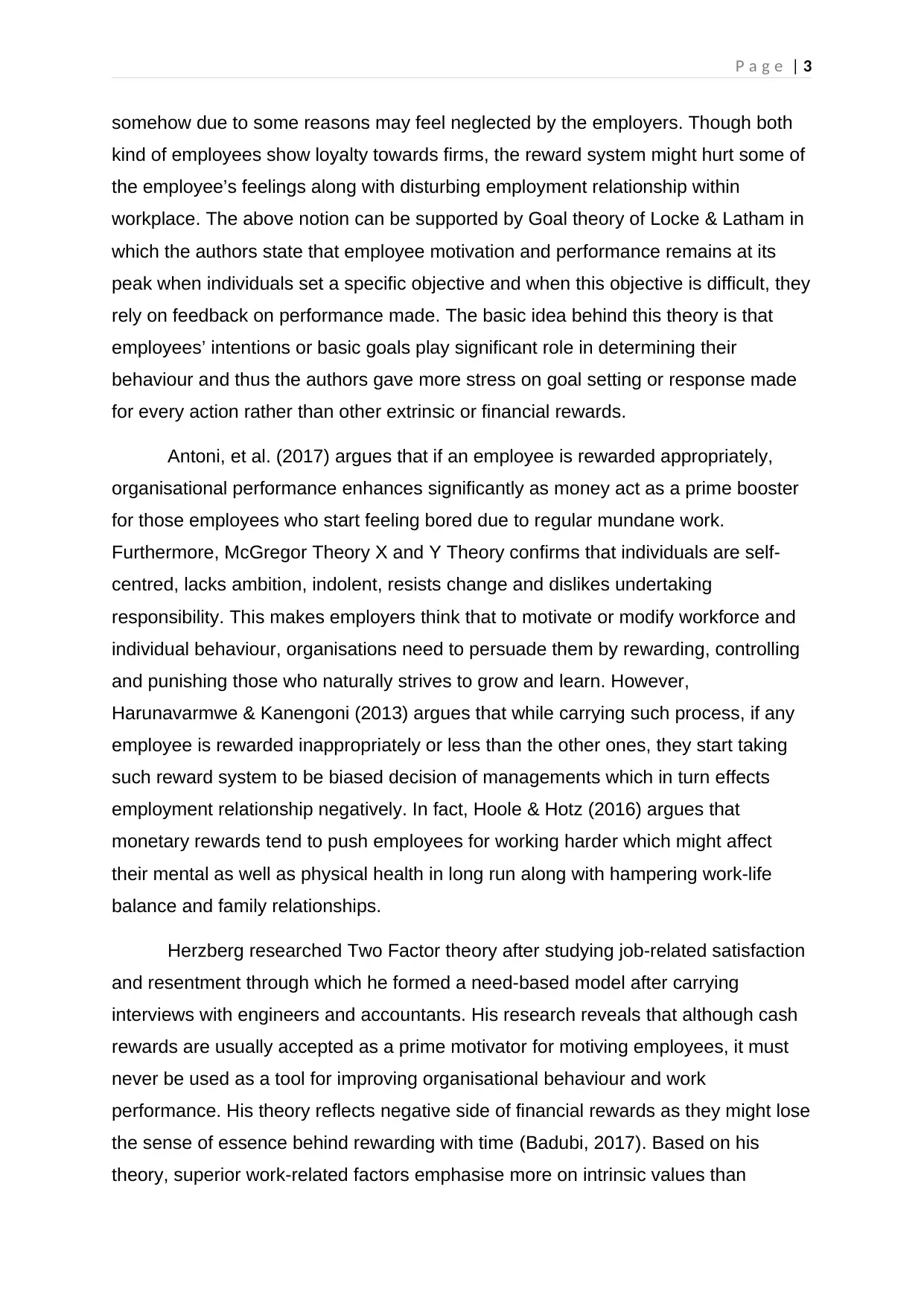
P a g e | 3
somehow due to some reasons may feel neglected by the employers. Though both
kind of employees show loyalty towards firms, the reward system might hurt some of
the employee’s feelings along with disturbing employment relationship within
workplace. The above notion can be supported by Goal theory of Locke & Latham in
which the authors state that employee motivation and performance remains at its
peak when individuals set a specific objective and when this objective is difficult, they
rely on feedback on performance made. The basic idea behind this theory is that
employees’ intentions or basic goals play significant role in determining their
behaviour and thus the authors gave more stress on goal setting or response made
for every action rather than other extrinsic or financial rewards.
Antoni, et al. (2017) argues that if an employee is rewarded appropriately,
organisational performance enhances significantly as money act as a prime booster
for those employees who start feeling bored due to regular mundane work.
Furthermore, McGregor Theory X and Y Theory confirms that individuals are self-
centred, lacks ambition, indolent, resists change and dislikes undertaking
responsibility. This makes employers think that to motivate or modify workforce and
individual behaviour, organisations need to persuade them by rewarding, controlling
and punishing those who naturally strives to grow and learn. However,
Harunavarmwe & Kanengoni (2013) argues that while carrying such process, if any
employee is rewarded inappropriately or less than the other ones, they start taking
such reward system to be biased decision of managements which in turn effects
employment relationship negatively. In fact, Hoole & Hotz (2016) argues that
monetary rewards tend to push employees for working harder which might affect
their mental as well as physical health in long run along with hampering work-life
balance and family relationships.
Herzberg researched Two Factor theory after studying job-related satisfaction
and resentment through which he formed a need-based model after carrying
interviews with engineers and accountants. His research reveals that although cash
rewards are usually accepted as a prime motivator for motiving employees, it must
never be used as a tool for improving organisational behaviour and work
performance. His theory reflects negative side of financial rewards as they might lose
the sense of essence behind rewarding with time (Badubi, 2017). Based on his
theory, superior work-related factors emphasise more on intrinsic values than
somehow due to some reasons may feel neglected by the employers. Though both
kind of employees show loyalty towards firms, the reward system might hurt some of
the employee’s feelings along with disturbing employment relationship within
workplace. The above notion can be supported by Goal theory of Locke & Latham in
which the authors state that employee motivation and performance remains at its
peak when individuals set a specific objective and when this objective is difficult, they
rely on feedback on performance made. The basic idea behind this theory is that
employees’ intentions or basic goals play significant role in determining their
behaviour and thus the authors gave more stress on goal setting or response made
for every action rather than other extrinsic or financial rewards.
Antoni, et al. (2017) argues that if an employee is rewarded appropriately,
organisational performance enhances significantly as money act as a prime booster
for those employees who start feeling bored due to regular mundane work.
Furthermore, McGregor Theory X and Y Theory confirms that individuals are self-
centred, lacks ambition, indolent, resists change and dislikes undertaking
responsibility. This makes employers think that to motivate or modify workforce and
individual behaviour, organisations need to persuade them by rewarding, controlling
and punishing those who naturally strives to grow and learn. However,
Harunavarmwe & Kanengoni (2013) argues that while carrying such process, if any
employee is rewarded inappropriately or less than the other ones, they start taking
such reward system to be biased decision of managements which in turn effects
employment relationship negatively. In fact, Hoole & Hotz (2016) argues that
monetary rewards tend to push employees for working harder which might affect
their mental as well as physical health in long run along with hampering work-life
balance and family relationships.
Herzberg researched Two Factor theory after studying job-related satisfaction
and resentment through which he formed a need-based model after carrying
interviews with engineers and accountants. His research reveals that although cash
rewards are usually accepted as a prime motivator for motiving employees, it must
never be used as a tool for improving organisational behaviour and work
performance. His theory reflects negative side of financial rewards as they might lose
the sense of essence behind rewarding with time (Badubi, 2017). Based on his
theory, superior work-related factors emphasise more on intrinsic values than
Paraphrase This Document
Need a fresh take? Get an instant paraphrase of this document with our AI Paraphraser
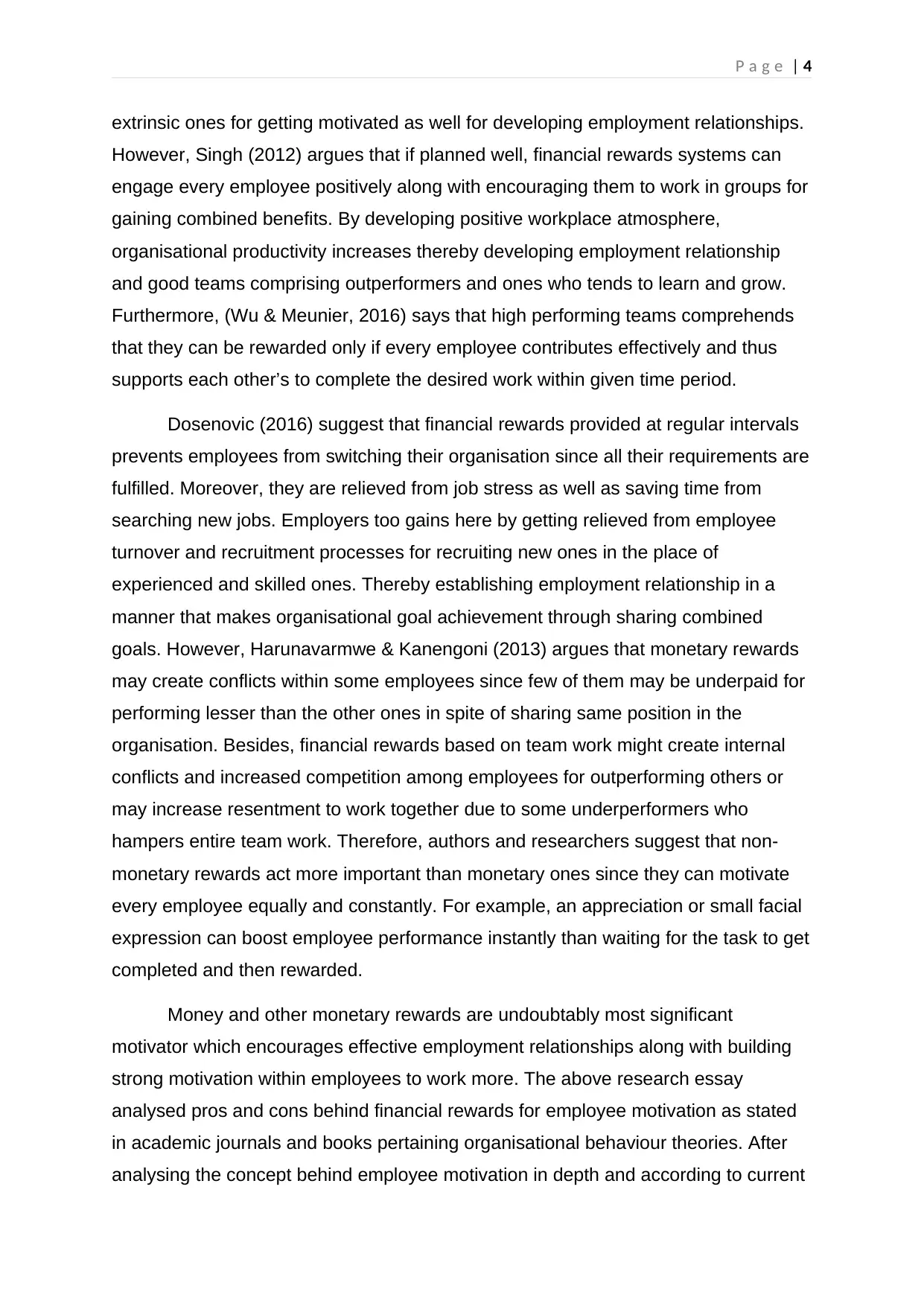
P a g e | 4
extrinsic ones for getting motivated as well for developing employment relationships.
However, Singh (2012) argues that if planned well, financial rewards systems can
engage every employee positively along with encouraging them to work in groups for
gaining combined benefits. By developing positive workplace atmosphere,
organisational productivity increases thereby developing employment relationship
and good teams comprising outperformers and ones who tends to learn and grow.
Furthermore, (Wu & Meunier, 2016) says that high performing teams comprehends
that they can be rewarded only if every employee contributes effectively and thus
supports each other’s to complete the desired work within given time period.
Dosenovic (2016) suggest that financial rewards provided at regular intervals
prevents employees from switching their organisation since all their requirements are
fulfilled. Moreover, they are relieved from job stress as well as saving time from
searching new jobs. Employers too gains here by getting relieved from employee
turnover and recruitment processes for recruiting new ones in the place of
experienced and skilled ones. Thereby establishing employment relationship in a
manner that makes organisational goal achievement through sharing combined
goals. However, Harunavarmwe & Kanengoni (2013) argues that monetary rewards
may create conflicts within some employees since few of them may be underpaid for
performing lesser than the other ones in spite of sharing same position in the
organisation. Besides, financial rewards based on team work might create internal
conflicts and increased competition among employees for outperforming others or
may increase resentment to work together due to some underperformers who
hampers entire team work. Therefore, authors and researchers suggest that non-
monetary rewards act more important than monetary ones since they can motivate
every employee equally and constantly. For example, an appreciation or small facial
expression can boost employee performance instantly than waiting for the task to get
completed and then rewarded.
Money and other monetary rewards are undoubtably most significant
motivator which encourages effective employment relationships along with building
strong motivation within employees to work more. The above research essay
analysed pros and cons behind financial rewards for employee motivation as stated
in academic journals and books pertaining organisational behaviour theories. After
analysing the concept behind employee motivation in depth and according to current
extrinsic ones for getting motivated as well for developing employment relationships.
However, Singh (2012) argues that if planned well, financial rewards systems can
engage every employee positively along with encouraging them to work in groups for
gaining combined benefits. By developing positive workplace atmosphere,
organisational productivity increases thereby developing employment relationship
and good teams comprising outperformers and ones who tends to learn and grow.
Furthermore, (Wu & Meunier, 2016) says that high performing teams comprehends
that they can be rewarded only if every employee contributes effectively and thus
supports each other’s to complete the desired work within given time period.
Dosenovic (2016) suggest that financial rewards provided at regular intervals
prevents employees from switching their organisation since all their requirements are
fulfilled. Moreover, they are relieved from job stress as well as saving time from
searching new jobs. Employers too gains here by getting relieved from employee
turnover and recruitment processes for recruiting new ones in the place of
experienced and skilled ones. Thereby establishing employment relationship in a
manner that makes organisational goal achievement through sharing combined
goals. However, Harunavarmwe & Kanengoni (2013) argues that monetary rewards
may create conflicts within some employees since few of them may be underpaid for
performing lesser than the other ones in spite of sharing same position in the
organisation. Besides, financial rewards based on team work might create internal
conflicts and increased competition among employees for outperforming others or
may increase resentment to work together due to some underperformers who
hampers entire team work. Therefore, authors and researchers suggest that non-
monetary rewards act more important than monetary ones since they can motivate
every employee equally and constantly. For example, an appreciation or small facial
expression can boost employee performance instantly than waiting for the task to get
completed and then rewarded.
Money and other monetary rewards are undoubtably most significant
motivator which encourages effective employment relationships along with building
strong motivation within employees to work more. The above research essay
analysed pros and cons behind financial rewards for employee motivation as stated
in academic journals and books pertaining organisational behaviour theories. After
analysing the concept behind employee motivation in depth and according to current
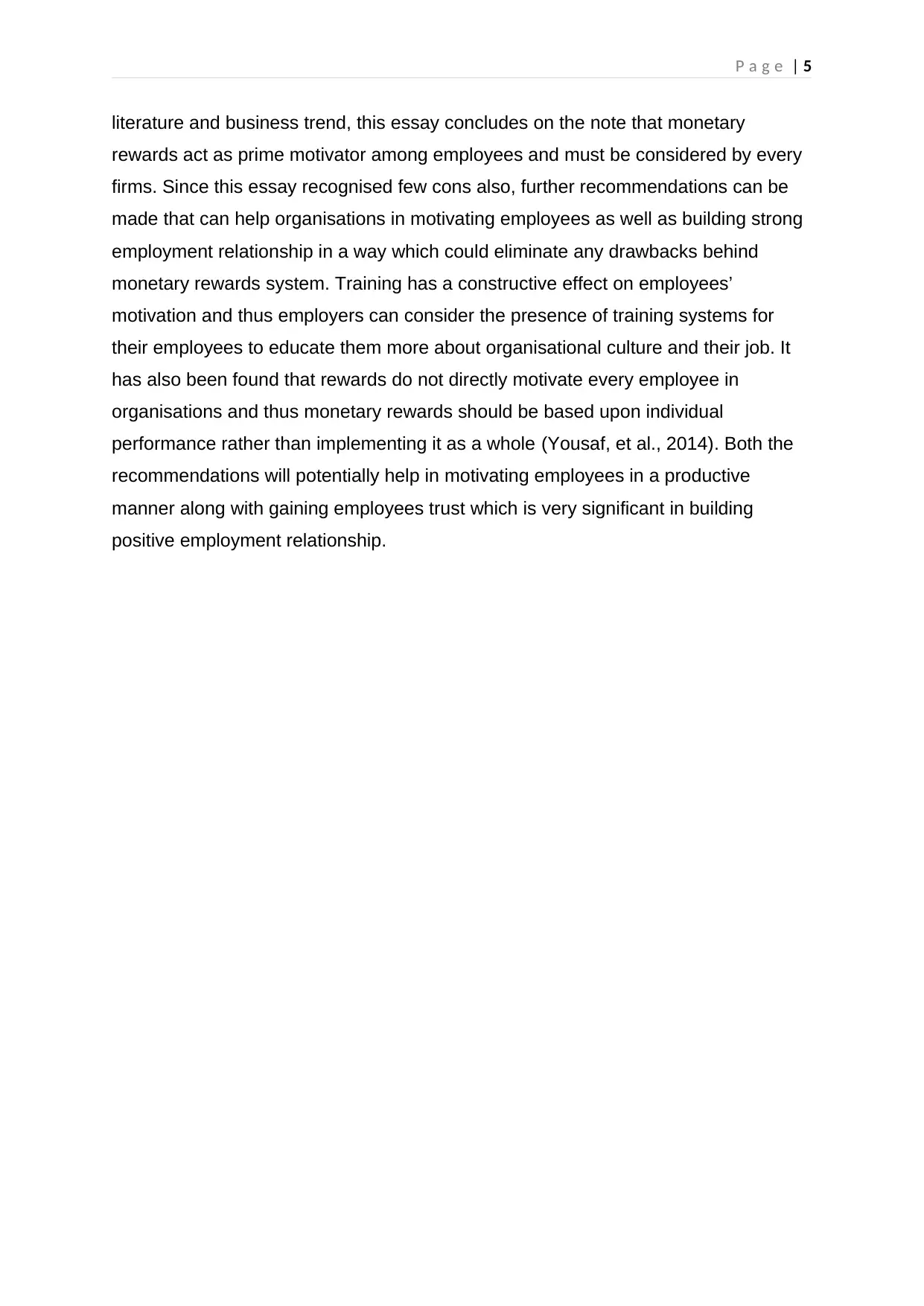
P a g e | 5
literature and business trend, this essay concludes on the note that monetary
rewards act as prime motivator among employees and must be considered by every
firms. Since this essay recognised few cons also, further recommendations can be
made that can help organisations in motivating employees as well as building strong
employment relationship in a way which could eliminate any drawbacks behind
monetary rewards system. Training has a constructive effect on employees’
motivation and thus employers can consider the presence of training systems for
their employees to educate them more about organisational culture and their job. It
has also been found that rewards do not directly motivate every employee in
organisations and thus monetary rewards should be based upon individual
performance rather than implementing it as a whole (Yousaf, et al., 2014). Both the
recommendations will potentially help in motivating employees in a productive
manner along with gaining employees trust which is very significant in building
positive employment relationship.
literature and business trend, this essay concludes on the note that monetary
rewards act as prime motivator among employees and must be considered by every
firms. Since this essay recognised few cons also, further recommendations can be
made that can help organisations in motivating employees as well as building strong
employment relationship in a way which could eliminate any drawbacks behind
monetary rewards system. Training has a constructive effect on employees’
motivation and thus employers can consider the presence of training systems for
their employees to educate them more about organisational culture and their job. It
has also been found that rewards do not directly motivate every employee in
organisations and thus monetary rewards should be based upon individual
performance rather than implementing it as a whole (Yousaf, et al., 2014). Both the
recommendations will potentially help in motivating employees in a productive
manner along with gaining employees trust which is very significant in building
positive employment relationship.
⊘ This is a preview!⊘
Do you want full access?
Subscribe today to unlock all pages.

Trusted by 1+ million students worldwide
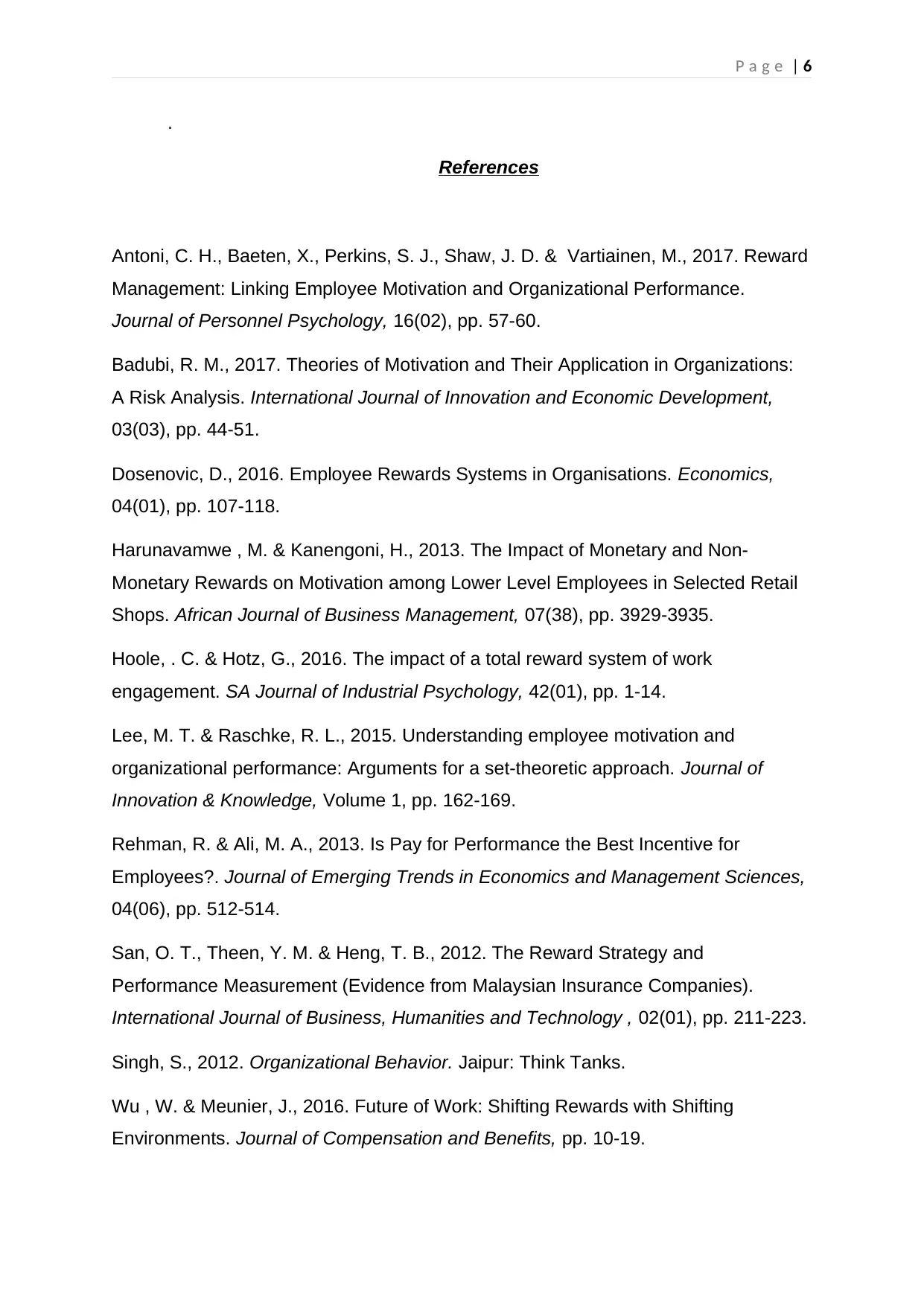
P a g e | 6
.
References
Antoni, C. H., Baeten, X., Perkins, S. J., Shaw, J. D. & Vartiainen, M., 2017. Reward
Management: Linking Employee Motivation and Organizational Performance.
Journal of Personnel Psychology, 16(02), pp. 57-60.
Badubi, R. M., 2017. Theories of Motivation and Their Application in Organizations:
A Risk Analysis. International Journal of Innovation and Economic Development,
03(03), pp. 44-51.
Dosenovic, D., 2016. Employee Rewards Systems in Organisations. Economics,
04(01), pp. 107-118.
Harunavamwe , M. & Kanengoni, H., 2013. The Impact of Monetary and Non-
Monetary Rewards on Motivation among Lower Level Employees in Selected Retail
Shops. African Journal of Business Management, 07(38), pp. 3929-3935.
Hoole, . C. & Hotz, G., 2016. The impact of a total reward system of work
engagement. SA Journal of Industrial Psychology, 42(01), pp. 1-14.
Lee, M. T. & Raschke, R. L., 2015. Understanding employee motivation and
organizational performance: Arguments for a set-theoretic approach. Journal of
Innovation & Knowledge, Volume 1, pp. 162-169.
Rehman, R. & Ali, M. A., 2013. Is Pay for Performance the Best Incentive for
Employees?. Journal of Emerging Trends in Economics and Management Sciences,
04(06), pp. 512-514.
San, O. T., Theen, Y. M. & Heng, T. B., 2012. The Reward Strategy and
Performance Measurement (Evidence from Malaysian Insurance Companies).
International Journal of Business, Humanities and Technology , 02(01), pp. 211-223.
Singh, S., 2012. Organizational Behavior. Jaipur: Think Tanks.
Wu , W. & Meunier, J., 2016. Future of Work: Shifting Rewards with Shifting
Environments. Journal of Compensation and Benefits, pp. 10-19.
.
References
Antoni, C. H., Baeten, X., Perkins, S. J., Shaw, J. D. & Vartiainen, M., 2017. Reward
Management: Linking Employee Motivation and Organizational Performance.
Journal of Personnel Psychology, 16(02), pp. 57-60.
Badubi, R. M., 2017. Theories of Motivation and Their Application in Organizations:
A Risk Analysis. International Journal of Innovation and Economic Development,
03(03), pp. 44-51.
Dosenovic, D., 2016. Employee Rewards Systems in Organisations. Economics,
04(01), pp. 107-118.
Harunavamwe , M. & Kanengoni, H., 2013. The Impact of Monetary and Non-
Monetary Rewards on Motivation among Lower Level Employees in Selected Retail
Shops. African Journal of Business Management, 07(38), pp. 3929-3935.
Hoole, . C. & Hotz, G., 2016. The impact of a total reward system of work
engagement. SA Journal of Industrial Psychology, 42(01), pp. 1-14.
Lee, M. T. & Raschke, R. L., 2015. Understanding employee motivation and
organizational performance: Arguments for a set-theoretic approach. Journal of
Innovation & Knowledge, Volume 1, pp. 162-169.
Rehman, R. & Ali, M. A., 2013. Is Pay for Performance the Best Incentive for
Employees?. Journal of Emerging Trends in Economics and Management Sciences,
04(06), pp. 512-514.
San, O. T., Theen, Y. M. & Heng, T. B., 2012. The Reward Strategy and
Performance Measurement (Evidence from Malaysian Insurance Companies).
International Journal of Business, Humanities and Technology , 02(01), pp. 211-223.
Singh, S., 2012. Organizational Behavior. Jaipur: Think Tanks.
Wu , W. & Meunier, J., 2016. Future of Work: Shifting Rewards with Shifting
Environments. Journal of Compensation and Benefits, pp. 10-19.
Paraphrase This Document
Need a fresh take? Get an instant paraphrase of this document with our AI Paraphraser
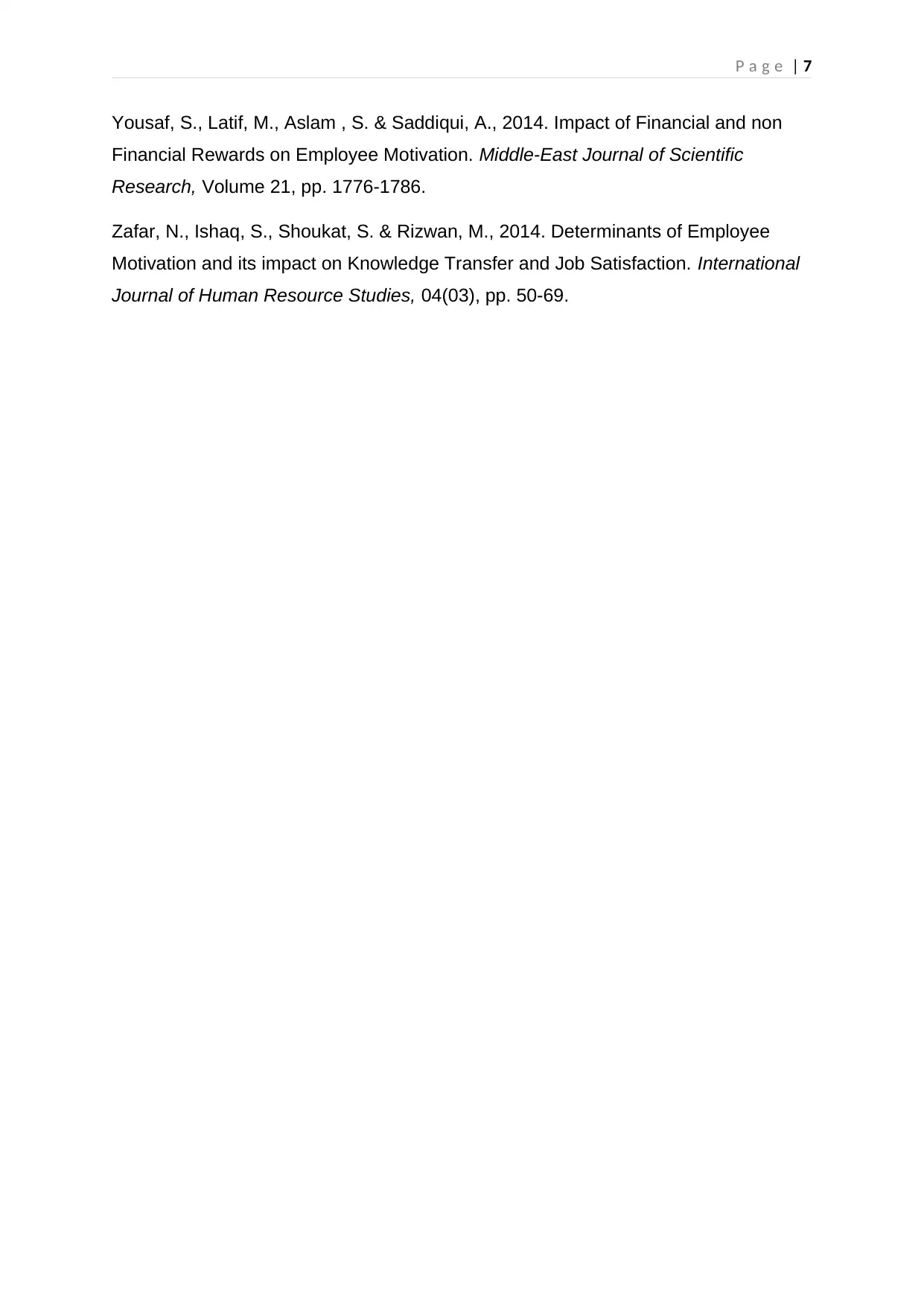
P a g e | 7
Yousaf, S., Latif, M., Aslam , S. & Saddiqui, A., 2014. Impact of Financial and non
Financial Rewards on Employee Motivation. Middle-East Journal of Scientific
Research, Volume 21, pp. 1776-1786.
Zafar, N., Ishaq, S., Shoukat, S. & Rizwan, M., 2014. Determinants of Employee
Motivation and its impact on Knowledge Transfer and Job Satisfaction. International
Journal of Human Resource Studies, 04(03), pp. 50-69.
Yousaf, S., Latif, M., Aslam , S. & Saddiqui, A., 2014. Impact of Financial and non
Financial Rewards on Employee Motivation. Middle-East Journal of Scientific
Research, Volume 21, pp. 1776-1786.
Zafar, N., Ishaq, S., Shoukat, S. & Rizwan, M., 2014. Determinants of Employee
Motivation and its impact on Knowledge Transfer and Job Satisfaction. International
Journal of Human Resource Studies, 04(03), pp. 50-69.
1 out of 8
Related Documents
Your All-in-One AI-Powered Toolkit for Academic Success.
+13062052269
info@desklib.com
Available 24*7 on WhatsApp / Email
![[object Object]](/_next/static/media/star-bottom.7253800d.svg)
Unlock your academic potential
Copyright © 2020–2025 A2Z Services. All Rights Reserved. Developed and managed by ZUCOL.




